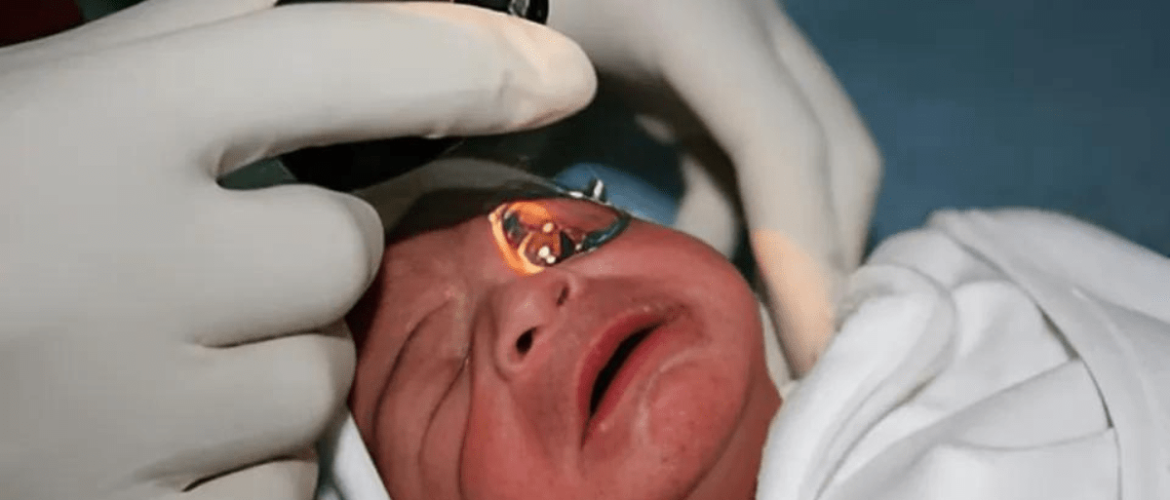A baby’s eyes start to develop at around the sixth week of pregnancy. At this point, the eyes are just two small protrusions emanating from the brain. In the months that follow, these protrusions grow and become increasingly complex.
When babies are born prematurely, their eye development is interrupted. Babies who are born before 32 weeks of gestation or weigh 2000 grams or less are vulnerable to a potentially blinding eye disorder known as Retinopathy of Prematurity (ROP). The smaller the babies at birth, the more likely they will develop this potentially debilitating disorder.
What is Retinopathy of Prematurity (ROP)?
Retinopathy of Prematurity (ROP) occurs due to abnormal growth of blood vessels in an infant’s eye. During development, blood vessels grow from the central part of the retina outwards. This process is completed few weeks before the normal time of delivery. However, in premature babies, it is incomplete. If blood vessels grow normally, ROP does not occur. On the contrary, if the vessels grow and branch abnormally the pre-term baby develops ROP.
What are the factors for developing ROP?
The two biggest risk factors for developing ROP are:
- premature birth (most common in babies born more than 12 weeks early) and
- low birth weight (most common in 11% – 56% of preterm infants with low birth weight).
Other factors can also place these babies at higher risk of ROP. These include:
- prolonged use of oxygen (for their lungs)
- sepsis (blood infection)
- blood transfusion
- jaundice
- low weight gain
- low platelets
- anaemia (low haemoglobin)
- intraventricular haemorrhage (bleeding in the brain), etc.
If your baby is born premature, you may have concerns about ROP affecting your child’s vision. We at MM Joshi Eye Institute, recommend ROP screening within the first few weeks of birth of premature babies or babies that weigh less than 2 kgs.
Incidence of ROP
The incidence of ROP in India is between 38 – 51.9% and it is as high as 80 – 100% in infants weighing <900 grams at birth or with a gestational age of <25 weeks. With the improved NICU care resulting in survival of preterm babies, the incidence of ROP has increased. Unfortunately there is no proportionate increase in awareness among the medical fraternity. In the absence of an effective ROP screening strategy an increasing number of children who could have been successfully managed are going irreversibly blind. The socio-economic burden of such childhood blindness is immense.
Are there any signs or symptoms of ROP?
Unfortunately, there are no visible signs of ROP externally when it develops in a new-born. Hence, many parents do not get their newborn babies screened on time. In late stages of ROP, there is a white reflex (leukocoria) in the center of the pupil (round black portion of the eye). Sadly, by the time there are signs (when the baby is 4 – 6 weeks old) it is too late to save the baby’s vision.
An untreated infant with advanced ROP will have poor vision, poor eye contact with the parent, abnormal shaking of the eyes (nystagmus), and often delayed milestones as well.
Why is ROP screening important?
The purpose of ROP screening in premature infants is early detection of the condition so that it can be treated effectively to prevent vision loss. Doctors cannot predict which preterm baby will develop ROP as there are no visible signs or symptoms of the condition in the early stages, therefore screening is crucial.
In India, the national ROP guidelines (2018) recommend that all babies born less than 2000 grams and/or premature (less than 34 weeks of gestation), must undergo their first ROP screening before they are 30 days old (30 day strategy).
Can ROP be treated?
ROP treatment depends on its severity. Some of the treatments do have side effects. Newer research has shown promising treatment of advanced ROP cases with a combination of traditional therapy and drugs.
1. Laser therapy: The standard treatment for advanced ROP, laser therapy burns away the area around the edge of the retina, which has no normal blood vessels. This procedure typically saves sight in the main part of the visual field, but at the cost of side (peripheral) vision.
2. Cryotherapy: This was the first treatment for ROP. Cryotherapy uses an instrument to freeze a specific part of the eye that extends beyond the edges of the retina. It is used rarely now because outcomes from laser therapy are generally better. As with laser therapy, this treatment also destroys some peripheral vision.
3. Medications: Anti-VEGF drugs work by blocking the overgrowth of blood vessels in the retina. The medication is injected into the eye of the infant. Although no drugs have received Food and Drug Administration (FDA) approval to treat ROP specifically, some medications approved for other uses are being explored as alternatives to laser therapy, or to be used in conjunction with it.
If you recently gave birth to a premature baby and are concerned about your baby’s vision, book an appointment with our experts at MM Joshi Eye Hospital to get your baby screened for Retinopathy of Prematurity.


No comments yet.